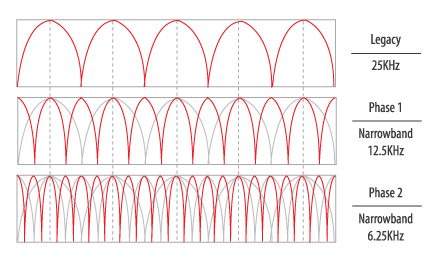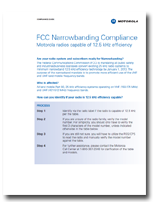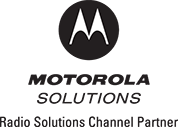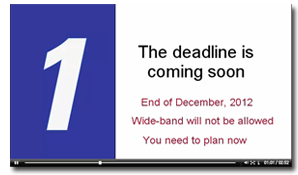Did you know about the recent FCC mandate requiring narrowbanding for all two-way radio systems? If you're found not to be in compliance by January 1, 2013, the penalties for your business or agency could be costly.
There's a shortage of usable radio frequencies available for the various technologies that depend on it, so the FCC recently made new frequencies accessible in-between existing ones. To eliminate the possibility of interference between these closely spaced frequencies, the FCC is requiring that all government agencies and businesses operating two-way radio systems on the frequencies between 150-512 MHz operate with a 12.5 kHz, or narrowband, bandwidth no later than January 1, 2013.
If you haven't already done so, you'll need to modify your FCC license to narrowband, and also convert your radio system to narrowband operation. This process might involve a simple reprogramming of your radios. However, for more complex systems the conversion may not be so simple. Plus, you might have older equipment that may not be efficient enough to meet the new standard, and will need to replace it.
Why risk the scrutiny of the FCC? Metro Mobile Communications has already converted many of our customers to narrowband, and we can help you meet these new requirements before the deadline, too. Set your mind at ease, and give us a call soon to discuss narrowbanding your radio system.

As a trusted leader in two-way communications, Metro Mobile has been supplying 12.5 Hz capable radios for over decade and offers the broadest choice of two-way radio equipment with close to 60 models capable of operating in 12.5 kHz efficiency. While radios purchased in the last ten years are likely dual mode 25/12.5 kHz, older equipment may need to be replaced. Contact us today to help you prepare for a smooth and cost effective transition.
FCC NARROWBANDING COMPLIANCE
WHAT YOU NEED TO KNOW
Are your radio system and subscribers ready for Narrowbanding?
The Federal Communications Commission (FCC) is mandating that all public safety and industrial/business licensees convert existing 25 kHz radio systems to narrowband 12.5 kHz efficiency systems by January 1, 2013. The purpose of the narrowband mandate is to promote more efficient use of the VHF and UHF land mobile frequency bands.
Who is affected?
All land mobile Part 90, 25 kHz efficiency systems operating on VHF (150-174 MHz) and UHF (421-512 MHz) frequency bands.
KEY DATES
The FCC has set the following deadlines for licensees and manufacturers, requiring migration to minimum 12.5 kHz efficiency systems.
RADIO USERS (LICENSEES)
January 1, 2011 Applications for new licenses or for license modifications to expand existing service areas must specify at least 12.5 kHz efficiency. The FCC will no longer accept applications for systems operating at 25 kHz efficiency.
January 1, 2013 All licensees must convert to and operate in at least 12.5 kHz efficiency. Existing dual mode (25/12.5 kHz) equipment must have the 25 kHz efficiency mode disabled via software. Equipment capable of operating only at 25 kHz efficiency must be replaced.
Note: The FCC has NOT set any date by which licensees must operate in 6.25 kHz efficiency in these bands.

NARROWBANDING FREQUENTLY ASKED QUESTIONS
What is Narrowbanding?
In an effort to promote more efficient use of spectrum, the FCC mandated all VHF and UHF Public Safety and Industrial /Business licensees using 25 kHz land mobile radio (LMR) systems migrate to narrowband 12.5 kHz efficiency technology by January 1, 2013.
MOTOROLA SUBSCRIBER RADIO NARROWBANDING CAPABILITY
Motorola Subscriber Radios and Stations Capable of Migrating to 12.5 kHz Efficiency

Download the Motorola Product Compliance Guide
PREPARING TO MEET THE MANDATE
With deadlines approaching rapidly, licensees who have not started their narrowband migration should considering the following steps today:
- Take an inventory of your radios to assess what equipment is capable of operating in 12.5 kHz and what will need to be replaced. The FCC has required all radios certified since 1997 to include a 12.5 kHz efficiency mode, most new equipment likely is dual mode 25/12.5 kHz that can be simple converted via software.
- Develop budget requirements and explore funding options.
- Establish a conversion and implementation schedule.
- Coordinate your conversion with neighboring agencies to facilitate continued interoperability among your agencies
- Conduct tests during conversion to ensure your system continues to provide similar coverage.
PLAN FOR THE LONGER - TERM WITH MOTOTRBO™
To meet later mandates planned by the FCC, consider new equipment that is capable of 6.25 kHz channels. These very narrowband systems are digital – your license should specify digital operations prior to use of this equipment.

- MOTOTRBO TDMA will provide improved Capacity and Capability with Reduced Costs
- MOTOTRBO provides 2 For 1 Channel Capacity for a 12.5kHz Channel
- MOTOTRBO or NXDN technology investments require emission update on licenses
- Simply adding a new emission designator does not require a frequency change
- Adding emission designator supports system transition
VIDEOS AND WEBINARS
Fleet Dispatch Network:
- Exclusive Frequencies
- Unlimited Airtime
- 100% Coverage
Get your FREE demo Now!
Consultants are Available:Monday - Friday
 ↑
↑
Two-Way Radio Systems and Public Safety Equipment in the San Francisco Bay Area
